Discover 11 hidden attractions, cool sights, and unusual things to do in Rochdale (United Kingdom). Don't miss out on these must-see attractions: Rochdale Town Hall, Rochdale Pioneers Museum, and Rochdale Cenotaph. Also, be sure to include Spotland Stadium in your itinerary.
Below, you can find the list of the most amazing places you should visit in Rochdale (England).
Table of Contents
Rochdale Town Hall
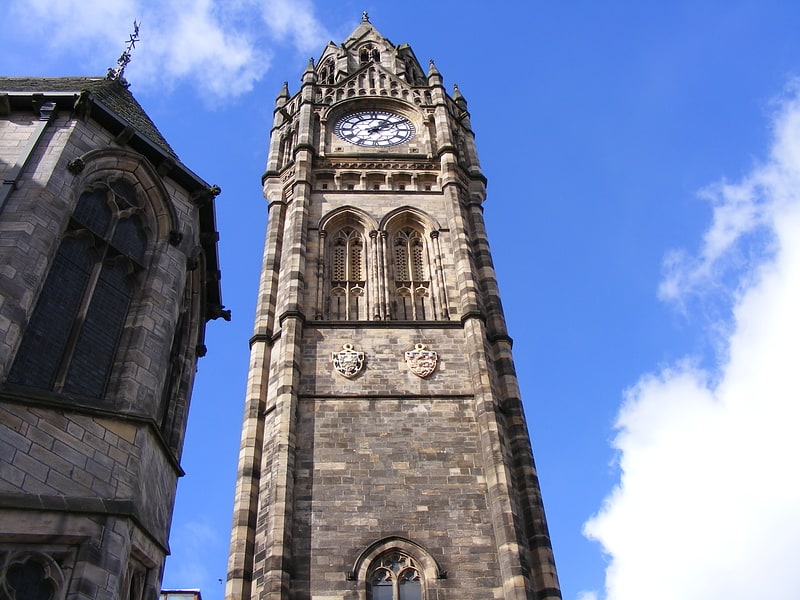
Building in Rochdale, England. Rochdale Town Hall is a Victorian-era municipal building in Rochdale, Greater Manchester, England. It is "widely recognised as being one of the finest municipal buildings in the country", and is recorded in the National Heritage List for England as a designated Grade I listed building. The Town Hall functions as the ceremonial headquarters of Rochdale Metropolitan Borough Council and houses local government departments, including the borough's civil registration office.
Built in the Gothic Revival style at a cost of £160,000 (£15.2 million in 2022), it was inaugurated for the governance of the Municipal Borough of Rochdale on 27 September 1871. The architect, William Henry Crossland, was the winner of a competition held in 1864 to design a new Town Hall. It had a 240-foot (73 m) clock tower topped by a wooden spire with a gilded statue of Saint George and the Dragon, both of which were destroyed by fire on 10 April 1883, leaving the building without a spire for four years. A new 190-foot (58 m) stone clock tower and spire in the style of Manchester Town Hall was designed by Alfred Waterhouse, and erected in 1887.
Architectural historian Nikolaus Pevsner described the building as possessing a "rare picturesque beauty". Its stained-glass windows are credited as "the finest modern examples of their kind". The building came to the attention of Adolf Hitler, who was said to have admired it so much that he wished to ship the building, brick-by-brick, to Nazi Germany had the United Kingdom been defeated in the Second World War.[1]
Address: Rochdale, The Esplanade, ROCHDALE, OL16 1AB
Rochdale Pioneers Museum
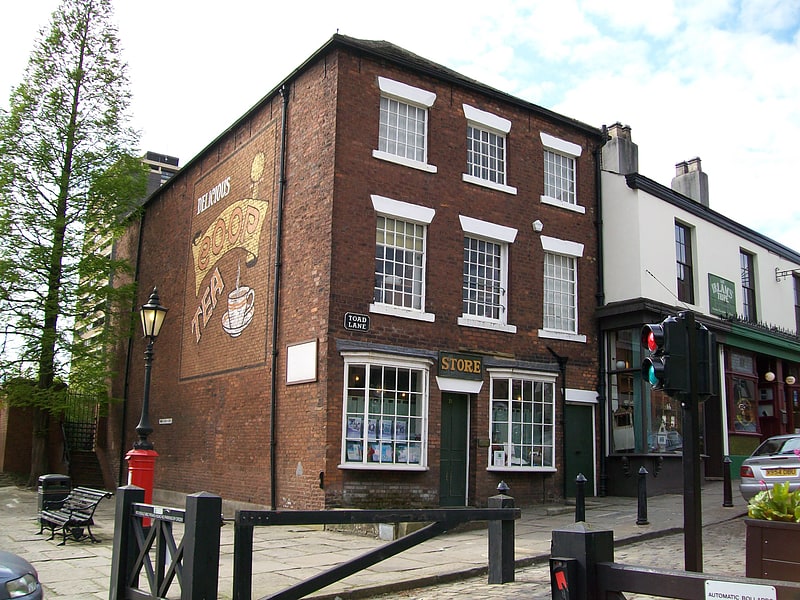
Museum in Rochdale, England. The Rochdale Pioneers Museum is housed in the building where the Rochdale Equitable Pioneers Society started trading on 21 December 1844. The museum is regarded as the birthplace of the modern co-operative movement. It is located in Rochdale, Greater Manchester, England.
The museum includes a recreation of the original shop, containing its rudimentary furniture, scales, items that were sold at the store, etc. Moreover, the museum transmits the influence of the co-operative movement on issues such as women's rights, poverty, education, fair trade and social reform. The museum is owned by the Co-operative Heritage Trust, and managed by the Co-operative College.[2]
Address: 31 Toad Lane, OL12 0NU Lancashire
Rochdale Cenotaph
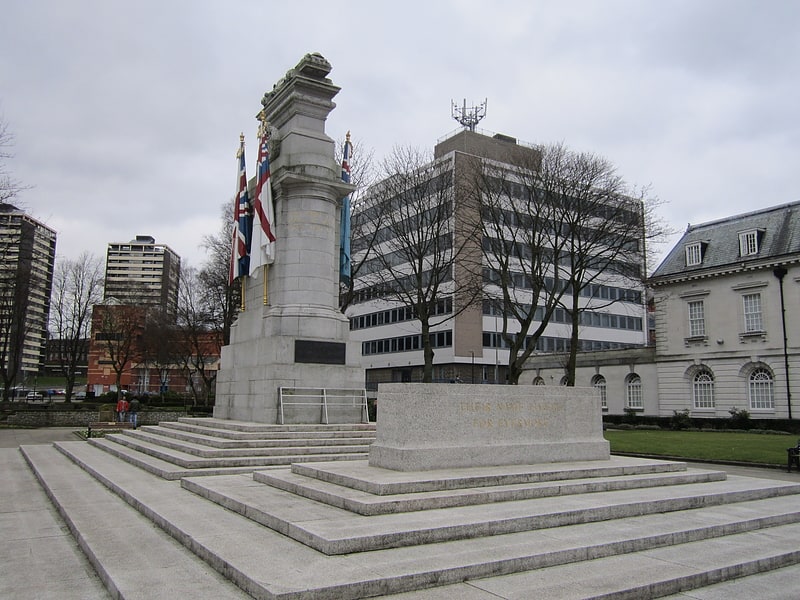
Monument in Rochdale, England. Rochdale Cenotaph is a First World War memorial on the Esplanade in Rochdale, Greater Manchester, in the north west of England. Designed by Sir Edwin Lutyens, it is one of seven memorials in England based on his Cenotaph in London and one of his more ambitious designs. The memorial was unveiled in 1922 and consists of a raised platform bearing Lutyens' characteristic Stone of Remembrance next to a 10-metre pylon topped by an effigy of a recumbent soldier. A set of painted stone flags surrounds the pylon.
A public meeting in February 1919 established a consensus to create a monument and a fund for the families of wounded servicemen. The meeting agreed to commission Lutyens to design the monument. His design for a bridge over the River Roch was abandoned after a local dignitary purchased a plot of land adjacent to Rochdale Town Hall and donated it for the site of the memorial. Lutyens revised his design, and Edward Stanley, 17th Earl of Derby, unveiled the memorial on 26 November 1922. It is a Grade I listed structure, having been upgraded in 2015 when Lutyens' war memorials were declared a national collection.[3]
Spotland Stadium
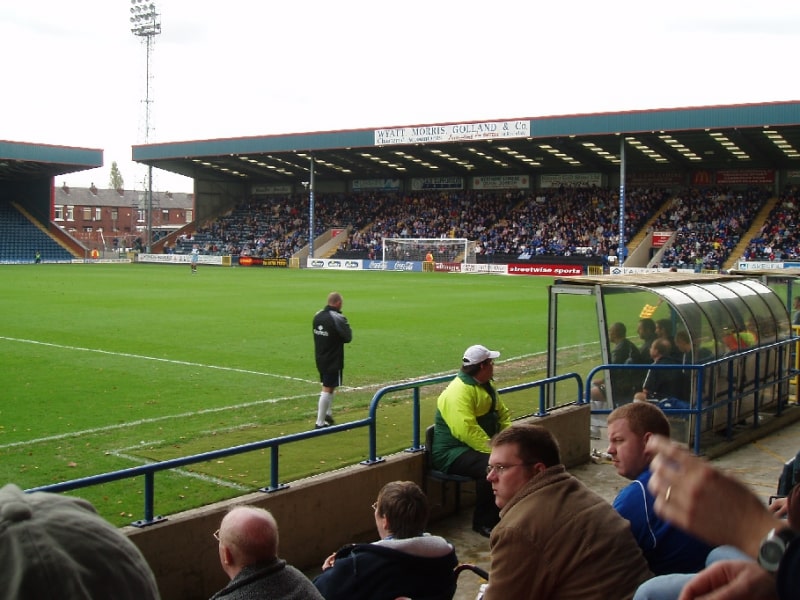
Stadium. Spotland Stadium, known as the Crown Oil Arena for sponsorship reasons, in the Spotland area of Rochdale, Greater Manchester, is home to Rochdale A.F.C. and Rochdale Hornets R.F.L.C. and has a capacity of 10,000.[4]
Address: Willbutts Ln, OL11 5DR Rochdale
Healey Dell Viaduct
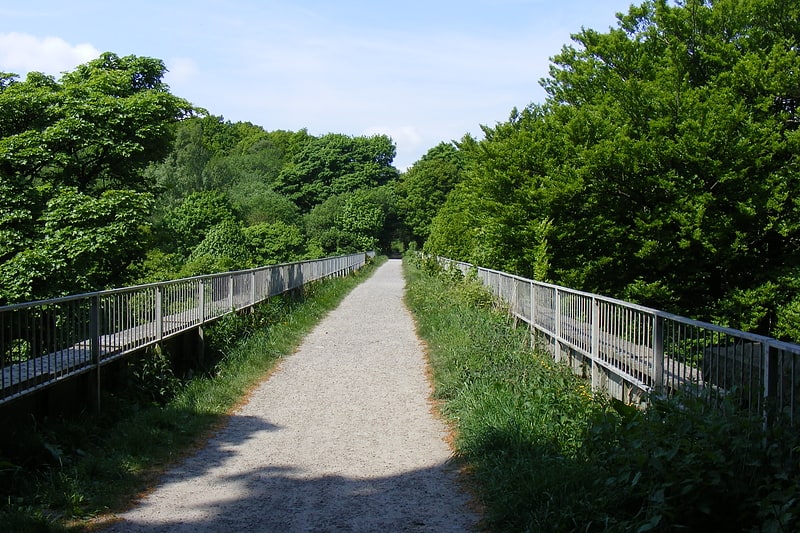
Healey Dell Viaduct is situated in Healey Dell Nature Reserve in the Spodden Valley, on the outskirts or Rochdale in Greater Manchester, England. It is 2½ miles from Whitworth, Lancashire. It was built in 1867 and carried the Rochdale to Bacup Railway Line, opening to passengers 1 November 1870. It operated until 1949, and carried coal trains until into the 1960s. Today it carries the National Cycle Network, Regional Network Route 92 which joins National Route 66.
The viaduct was built from locally quarried stone. It is 103 feet high above the river, with 8 arches, each with a 26 yards span.
Healey Dell is on the Rochdale Way and the Pennine Bridleway passes the northern end.[5]
Falinge Park

Park in Rochdale, England. Falinge Park is a Grade II listed public park located in Rochdale, Greater Manchester. Opened to the public in 1906, it lies in the historic grounds of the 18th century Falinge Hall.[6]
Touchstones Rochdale
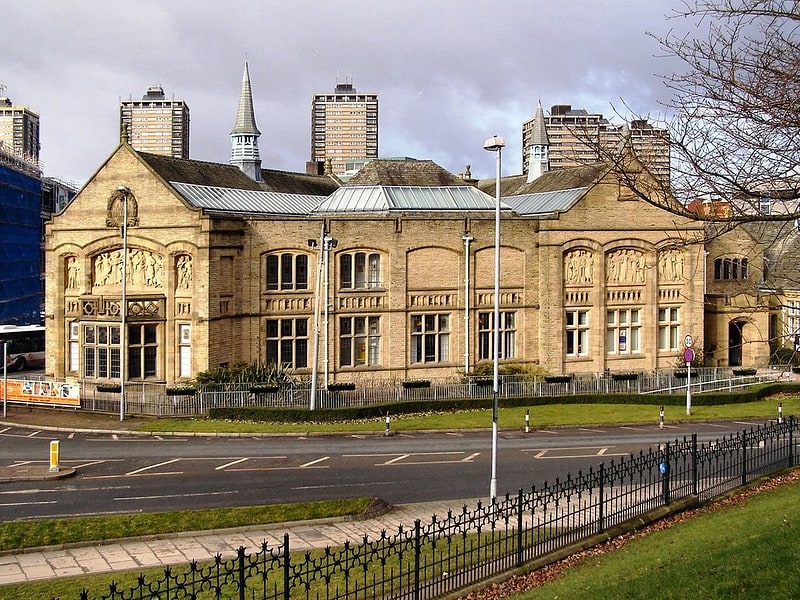
Art gallery in Rochdale, England. Touchstones Rochdale is an art gallery, museum, local studies centre, visitor information centre and café forming part of the Central Library, Museum and Art Gallery in Rochdale, Greater Manchester, England. It is a Grade II listed building.
The first part of the stone building was opened as a library in 1884 with the museum and gallery being added in 1903 and extended in 1913. It became an art and heritage centre in 2003. It houses collections relating to local history and related topics, with changing exhibitions over time.[7]
Address: The Esplanade, OL16 1AQ Rochdale
St John the Baptist's Church
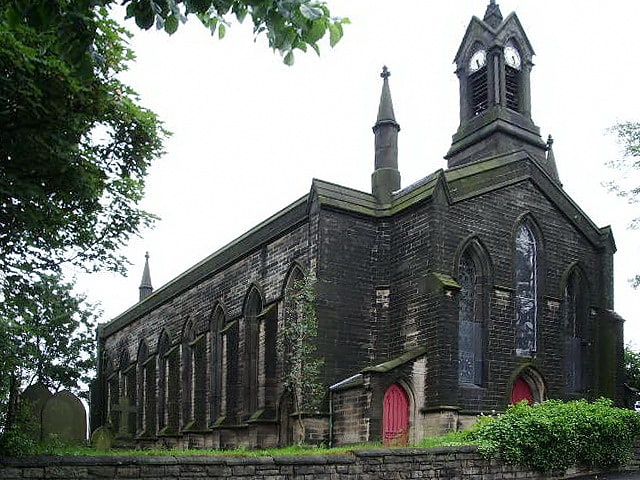
Church in Rochdale, England. St John the Baptist's Church is in Halifax Road, Smallbridge, Rochdale, Greater Manchester, England. It is a redundant Anglican parish church in the benefice of Wardle and Smallbridge, the deanery of Rochdale, the archdeaconry of Rochdale, and the diocese of Manchester. The church is recorded in the National Heritage List for England as a designated Grade II listed building. It was a Commissioners' church, having received a grant towards its construction from the Church Building Commission.[8]
Address: 5 Old Brow Ln, OL16 2QG Rochdale
Hollingworth Lake
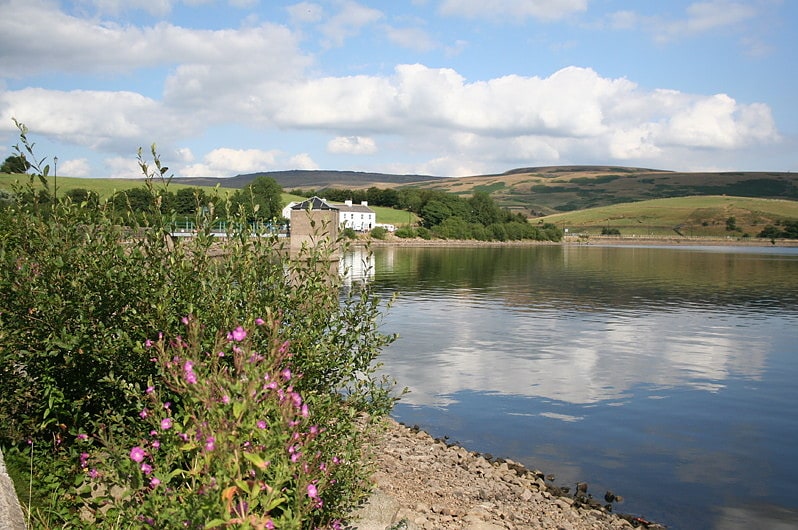
Reservoir in England. Hollingworth Lake is a 130-acre reservoir at Smithy Bridge in Littleborough, Greater Manchester, England. It was originally built as the main water source for the Rochdale Canal, but developed as a tourist resort from the 1860s. Hotels were built around it, helped by the arrival of the railway in 1839, which brought day-trippers and weekend visitors from Manchester, Bradford and Leeds.
The popularity of the lake as a resort declined in the early twentieth century and the area was used as an army camp in the First World War. The canal company sold the reservoir to Oldham and Rochdale Corporations for water supply in 1923. After the Second World War, boating rights were bought by Rochdale Council, who developed the area into the Hollingworth Lake Country Park in 1974. There has been a steady increase in facilities since, and it is now a thriving centre for water sports and other activities.
Hollingworth Lake Rowing Club has been in continuous existence since 1872.[9]
Watergrove Reservoir

Reservoir in England. Watergrove Reservoir is a reservoir close to Wardle in the Metropolitan Borough of Rochdale, within Greater Manchester, England.
Rochdale Corporation chose Watergrove as a suitable site to build a large reservoir largely to a prolonged drought in the 1930s, resulting in water regularly being bought from Oldham. The ruins of the old village of Watergrove submerged under the large expanse of water in 1938, and dotted around the landscape above the reservoir there are several ruins originally belonging to the village.
The book Watergrove: A History of the Valley and its Drowned Village by Allen Holt gives a personal view of the transition as the author grew up in Wardle, a mile to the south of Watergrove. Several photographs in the book show people walking along roads that have resurfaced during times of extreme drought.
In July 2008, a 13-year-old boy, Joseph Thomas, was found dead in the reservoir after he had gone swimming with friends.
A free, weekly, 5 km parkrun takes place every Saturday morning. The event is hosted by local volunteers and was first held on Saturday 7 June 2014.[10]
St John the Baptist Church
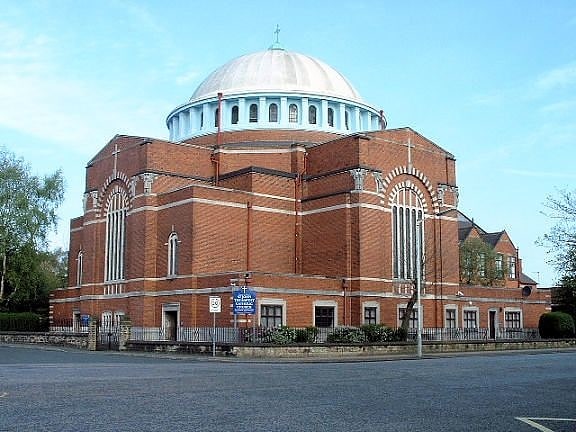
St John the Baptist Church is a Roman Catholic Parish church in Rochdale, Greater Manchester, England. It was founded in 1830, and built in 1927. It is situated on the corner of Maclure Road and Dowling Street, opposite the Greater Manchester Fire Service Museum in the centre of the town. It was built in the Byzantine Revival style and is a Grade II* listed building.[11]